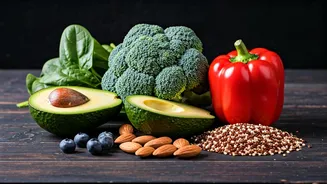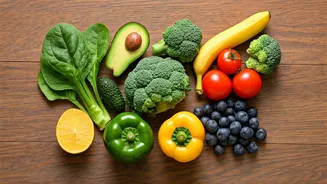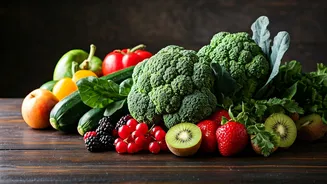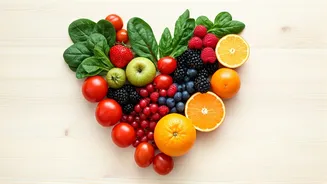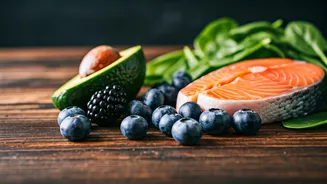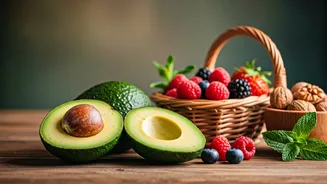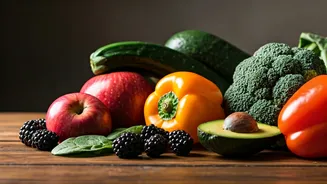Introduction to Blood Sugar
Understanding blood sugar regulation is crucial for overall health. Blood sugar, or glucose, is the primary source of energy for your body, derived from
the food you eat. It's carried in the bloodstream and utilized by cells for various functions. Maintaining optimal blood sugar levels prevents both hyperglycemia (high blood sugar) and hypoglycemia (low blood sugar), which can lead to various health complications. Diet plays a pivotal role in regulating these levels, with certain foods having a more positive impact on glycemic control than others. Therefore, choosing the right foods is a foundational step in managing blood sugar. This article delves into seven specific vegetarian food choices, detailing how they can support healthy blood sugar levels.
Lentils and Blood Sugar
Lentils are an excellent source of dietary fiber and complex carbohydrates, making them a beneficial food for blood sugar management. When consumed, lentils break down slowly, leading to a gradual release of glucose into the bloodstream. This slow release prevents the rapid spikes often associated with simple carbohydrates, helping to maintain stable blood sugar levels. Furthermore, lentils are rich in protein, which also contributes to satiety, potentially reducing overall calorie intake. The fiber content also aids in digestive health, which indirectly supports glucose control by improving insulin sensitivity. Including lentils in your diet can be as simple as adding them to soups, salads, or as a side dish, making them a versatile and health-promoting option for those focused on managing their blood sugar.
Leafy Green Vegetables
Leafy green vegetables, such as spinach, kale, and collard greens, are low in carbohydrates and calories, while packed with nutrients and fiber. They have a minimal impact on blood sugar levels, making them a safe choice for individuals managing their glucose. The high fiber content also helps to slow the absorption of glucose, preventing sharp increases. These greens are also rich in antioxidants, which can reduce inflammation and improve insulin sensitivity. The vitamins and minerals in leafy greens further contribute to overall health, providing essential nutrients that support various bodily functions. Preparing these vegetables is flexible; they can be added to smoothies, salads, or lightly cooked. Regular consumption of leafy greens can greatly benefit individuals monitoring their blood sugar levels.
Berries and Benefits
Berries, including blueberries, strawberries, and raspberries, are another beneficial addition to a blood sugar-conscious diet. Although they contain some natural sugars, berries are rich in fiber and antioxidants. The fiber content slows down sugar absorption, preventing dramatic spikes in blood sugar. Moreover, berries are filled with antioxidants that can improve insulin resistance, helping your body to use insulin more effectively. Regular consumption of berries has been linked to better metabolic health and decreased risk of chronic diseases. They can be enjoyed fresh, added to yogurt or oatmeal, or included in smoothies. Berries combine great taste and substantial health benefits, making them a sweet choice for anyone seeking to support their blood sugar levels naturally.
Nuts and Seeds
Nuts and seeds offer a healthy blend of fats, fiber, and protein, all of which support blood sugar regulation. These foods provide a low-carbohydrate option, which leads to little impact on blood glucose. The combination of protein, fiber, and healthy fats slows down the digestion and absorption of carbohydrates, promoting stable blood sugar levels. Nuts and seeds also contain various nutrients, including magnesium, which is important for insulin function. Portion control is essential because nuts and seeds are calorie-dense. Options include almonds, walnuts, chia seeds, and flax seeds. When eaten in moderation, nuts and seeds are a simple and nutritious addition to your diet. They’re great as snacks or added to salads and other meals, providing a filling and beneficial way to manage blood sugar.
Whole Grains and Health
Whole grains, such as brown rice, quinoa, and oats, provide a more substantial and complex carbohydrate profile compared to refined grains. They contain a good amount of fiber, which helps regulate the speed at which glucose is released into the bloodstream, avoiding sudden increases in blood sugar levels. They have a lower glycemic index (GI) compared to processed grains, which means they cause a slower and more gradual rise in blood sugar. Whole grains also provide essential nutrients, including B vitamins and minerals, which support overall health. Integrating whole grains into your diet can be as simple as substituting white rice with brown rice or choosing oatmeal over sugary cereals. When chosen over refined grains, whole grains offer significant health benefits, especially in managing blood sugar levels.
Avocados for Management
Avocados are renowned for their high healthy fat content, and they also provide a low-carbohydrate option that has a minimal effect on blood sugar. The healthy fats in avocados aid in slowing down carbohydrate digestion, supporting more stable blood sugar levels. They are also packed with fiber, which helps regulate glucose release and promotes a feeling of fullness. Furthermore, avocados contain a variety of vitamins and minerals, contributing to overall health and well-being. They can be enjoyed in various ways, like adding them to salads, making guacamole, or spreading them on whole-grain toast. The versatile nature of avocados, combined with their health benefits, makes them a valuable addition to any diet focused on maintaining healthy blood sugar levels.
